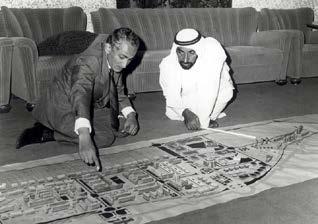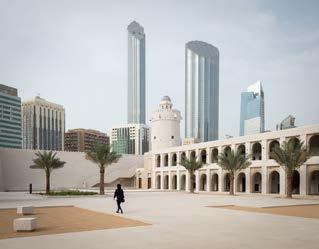
3 minute read
2.2 Contextualizing the UAE

Since its unification in 1971, the political changes with which the 1970’s opened for the seven states of the United Arab Emirates, are to be seen against the background of economic and social changes (Heard-Bey, 2017). The discovery of oil in the Gulf has led to the region undergoing rapid change, socially and infrastructurally, initially it is due to oil that throughout the whole region economic, social, and political patterns have been rapidly superimposed on traditional patterns (Heard-Bey, 2017). Resulting economic gain, brought to the country by foreign investment, primarily from the West has led to an idealization of Western social constructs. Due to a longing for a ‘modern’ Western way of life, echoed in government building policy, and ambitions of the population, the UAE urbanity faces a deep societal and cultural identity crisis (Rashid, Ara, & Abdalla, 2022).
Advertisement
This identity crisis is complimented by a love-hate relationship with manifestations of Western culture, the local population, and government is inclined to take from Western culture what appears to be ‘useful or desirable’. This frame of mind often draws local people in conflict with Arab immigrants amid the population (Heard-Bey, 2017). External influences are not limited to those of the West. Prior to the discovery of oil, external cultural influence came primarily from India, and from Arabs of the fertile crescent, apart from influencing the culture of the UAE, engineers from these countries characterized the Architecture of the UAE and the Gulf. (HeardBey, 2017).
The desire of the UAE to ‘reproduce the past’, has been a recurring pattern in the Arab world, and spurs a debate on the appropriateness of such an approach. This is due to the fact that rather than directly attempting to recreate the young architectural history of the Gulf, the Gulf countries often look beyond, towards the greater Arab world for cultural inspiration. One can compare the recent and current state of the Gulf countries architecturally and culturally to the duality in which Arab countries found themselves at the end of colonial rule. This period is well documented in Arabic literature of the time (late 19th, early 20th century). Arab writers conceived of themselves, and their societies as trapped between, on the one hand, the residual cultural formations represented by the great Arabic classical heritage, and on the other hand, the appeals of modernity and modernization that European institutions and educations seemed to offer them (Makdisi, 1995). A question often posed at the turn of the 19th century in the Arab world, and in the post oil period of the Gulf, and thus the UAE is “how can you be Arab and modern at the same time?” (Kraidy, 2018) As people did not desire the duality in which they found themselves, there was either the option to revive the indigenous, a standpoint advocated by traditionalists, or there was a movement named ‘Nahda’. The ‘Nahda’ movement insisted that the only way out of a double bind is to move forward in the direction of progress, development, modernization and ultimately the West (Makdisi, 1995). Although the term ‘Nahda’ is not applied to the current state of the Gulf, the similarity in cultural affairs leads to a viable comparison in which the Gulf has found, and still finds itself in a period of ‘Nahda’.
The
UAE
Gulf finds itself in differs clash of interests which was occurring in the rest of the Middle East throughout the 20th Century. In the UAE, migrant expatriates constitute to approximately 87% of the population (Al-Qassimi & Fabbri, 2022). This huge amount of foreign influx is de facto multiculturalism, where much of the social structure persists and directs the changes and serves to filter what is acceptable. This is de facto indigenous conservatism with which to face the continually incoming forces of globalization (Fox, Sabah, & Al Mutawa, 2006). The duality in which the UAE and the gulf finds itself is not only fueled by the idealization of Western constructs, but also with the huge amount of foreign people in the country, undoubtably causing a strain on cultural integrity.

As part of the development of the UAE, a lifestyle of leisure on the exotic Arabian Gulf was marketed, to attract tourism and retailing. Traditional Arabian symbols, combined with contemporary design created architectural manifestations of globalization. The synthesis of traditional and ultramodern is emblematic of Gulf society itself as a marriage of the latest technological innovation with a timeless social structure (Fox, Sabah, & Al Mutawa, 2006). This marriage, or lack thereof is a topic which will be discussed throughout this paper, whether architectural or societal. The way in which this duality is handled, and the way the UAE and the Gulf will approach further development will shape both the existing and the future of the country, having all-important implications on society. The UAE will have to consider its young history, as well as that of the greater Arab – Middle Eastern surrounding to inform itself on how to approach the future sensitively.


